CONTENTS, June 14, 2000

|
|
PLANET OF VISIONS--Major Theme Pavilion at EXPO 2000.
Photo: ©Glenn Loney, 2000/The Everett Collection.
|
[01] EXPO 2000 in Hannover: First Environmental World's Fair
[02] Free Shows at EXPO/Opera in the City
[03] Peter Stein's "Faust" Epic
[04] Two Nights at Hannover Opera
[05] "Gilgamesh" World Premiere
[06] "Rosenkavalier" Revival
[07] Opera & Ballet in Baroque Herrenhausen Gardens
[08] Full-House of Short Plays at Hannover Schauspiel
[09] Post-Modern Productions at Frankfurt Opera
[10] New Look at Mozart's "Così"
[11] Shifting Scenery for "Trovatore"
[12] Frankfurt's Schauspielhaus & Kammerspiele
[13] Artist Rosalie's "Dandelions" in Frankfurt's Palmengarten
[14] Hundreds of New Shows Set for Edinburgh Fringe Festival
You can use your browser's "find" function to skip to articles on any of these topics instead of scrolling down. Click the "FIND" button or drop down the "EDIT" menu and choose "FIND."
Copyright © 2000 Glenn Loney.
For editorial and commercial uses of the Glenn Loney INFOTOGRAPHY/ArtsArchive of international photo-images, contact THE EVERETT COLLECTION, 104 West 27th Street, NYC 10010. Phone: 212-255-8610/FAX: 212-255-8612.
For a selection of Glenn Loney's previous columns, click here.
SAVE THE RAIN-FORESTS!
EXPO 2000 in Hannover:
The First Environmental World's Fair!

|
|
COLOR BLOCKS AT EXPO 2000.
Photo: ©Glenn Loney, 2000/The Everett Collection.
|
The impressive and fascinating International Exposition which opened June 1 in Hannover [two n's in German] is Germany's first-ever World's Fair! As well as being the first fair dedicated to Environmental Issues!
Considering Germany's political and economic history in the 20th century, it is hardly surprising that the nation has not before sponsored such a fair. But now it has done so, enlisting over 180 nations, territories, and enclaves.
These guests have created pavilions celebrating their histories, contemporary cultures, and their announced concern for the world's resources and environment in the future.
Cutting the Rain-forests has become a major issue, as have the conservation of fossil-fuels and development of alternative energy sources.
These and similar concerns are addressed repeatedly—but imaginatively and variously—in national pavilion exhibits. But they are also the major focus of EXPO 2000's Theme Pavilions, housed in five immense permanent exhibition halls of the Hannover Messe.
Planet of Visions!
The most spectacular—in design, technology, content, and impact of message—is the Planet of Visions Pavilion. Not only is the future of human life imagined—in the 21st century and beyond. But these visions are also presented in walk-through, ride-through sequences which are astonishing.
On one endlessly moving inclined ramp, you can stand in place or stride forward as you wish. Slightly above and in front of your eyes are an endless loop of flat-screen TV monitors which show you the constantly aging face of a woman. This sequence is repeated on a giant walk-through screen as you leave the main area.
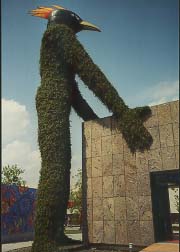
|
|
BIG BIRD--Andre Heller's environmental eye-catcher at EXPO 2000.
|
This pavilion alone is worth the trip to Hannover! It's also worth a long wait in line, thanks to the varied show-segments inside. Some pavilions, however, have long waiting-times, but the walk-through or ride-through is over in fifteen or twenty minutes.
To avoid waiting in line—especially in the summer sun—it's best to book guided tours. On these, you can choose which pavilions you most want to visit. No waiting in long lines!
Your guide takes you through the VIP entrances—the same doorways used by Chancellor Schröeder, the President of Brazil, and yours truly, with a Press Pass, of course!
The main themes in the five great halls explore EXPO 2000's slogan: "Humankind—Nature—Technology: A New World Arising." It's well worth noting that this is not just another World's Fair with nations boasting about their technological advances.
Mankind is at the center of all. If not quite in the old philosophical formulation: "Man is the Measure of All Things." Humankind has an entire hall to itself!
The remaining major halls feature Knowledge, Mobility, Work, Health, Energy, Nutrition, Environment, and Basic Needs.
Consumerism Runs Rampant!
Some of the elements of the latter are hilarious. The so-called "needs" of modern consumer societies are amusingly mocked with walk-through supermarket shelves laden with all kinds of colorfully packaged products. Gradually, the shelves are a disaster-area, depleted by ravenous shoppers.
This is followed by various garbage-dumps and refuse-heaps. That many of the products on display are American brand-names cannot be pure coincidence.
The final grand chamber of this pavilion is inhabited by Peter Schumann's Bread & Puppet Theatre—all the way to Hannover from Vermont—to add to the mockery of presumed needs at home when millions are starving in the Third World.
I very much enjoyed the Chemi-Drome gondola-ride through the Chemical Industries' section of the theme pavilions. It's a crash-course in the discoveries of chemistry which have made our lives better and safer. You even get some artificial smoke in the cancer-segment, and a spritz of water in the sneeze-section.
Along one wall of this hall was a row of hair-dryers. If you needed to rest a bit and sat down under one, you soon found you were getting a message on Women's Issues!
Despite the entire hall devoted to them, Health & Energy were disappointments. Half the hall was spotted with tall balloons with Energy & Health Factoids printed on them. In German.
The subsequent vast space was filled with hordes of vibrating recliners, presumably to restore the spirits and muscles of those who'd stood in line and scampered about the huge fairgrounds all day long.
The entire central Conference and Convention Complex was devoted to the needs and whims of the Press. Very good planning!
Albert Speer at Work!
In fact, the whole fair-ground layout, design overview, and architectural standards were the responsibility of the noted German architect, Albert Speer. If that name sounds familiar, yes, he is the heir of Hitler's favorite architect, Albert Speer. At least, like his namesake, he got things very well organized!
The actual EXPO 2000 fair-site is divided by a highway. To the already existing huge Messe-Hallen on the main land-block have been added new halls and buildings, notably Hall 13, which even has a book written about its design!
Unique national pavilions—which can be removed and recyled, or returned home after the fair—are also in this area. Across the highway is a much longer rectangular land-area, featuring major purpose-built national pavilions and providing parking.
The regional railway-station for the Hannover Messe has been grandly rebuilt into a major Post-Modernist stop for the ICEs and other through-trains. There is a people-mover from this to the Western Entrance, as well as from the parking-areas.
There are five main entrances to EXPO 2000, three of them served by new super-modern end-stations on the Hannover U-Bahn system. And there are free shuttle-buses both outside and inside the fair-grounds to help visitors cover the distances.
It is a now a customary promise of each World's Fair that major new structures will remain in place and find continued uses after the fairs are over. Those ghostly monuments in Flushing Meadows Park, on the way to JFK Airport, are a constant mockery.
At the Hannover Messe grounds, however, the Preussag Arena—for large-scale musical and cultural events; the concave glass-walled German Pavilion, and several other structures have obvious future uses.
Big Busts Featured by Germany!
The German Pavilion has several outstanding sections. The first involves a scrambling around scaffolds to experience close-up plaster models of great heads of famous historic and modern Germans.
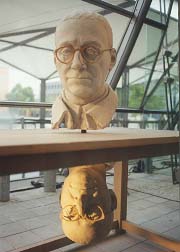
|
|
BERT BRECHT'S UPS & DOWNS--Bust in German Pavilion at EXPO 2000.
Photo: ©Glenn Loney, 2000/The Everett Collection.
|
These include Steffi Graf, Bert Brecht, Thomas Mann & Dog, Joseph Beuys, Albert Einstein, Lise Meintner, Rainer Werner Fassbinder, Heinrich Böll, Willy Brandt, Romy Schneider, Marlene Dietrich, the Brothers Grimm, Ludwig Beethoven, and Ludwig Mies van der Rohe.
The central experience in this pavilion is being effectually inside an environmental movie. Pavilion visitors choose different levels to enter a great space on catwalks The film is projected onto a number of screens, above, below, and around the viewers.
There are several 360-degree surround-screen shows at EXPO, as well as some with screens on the floors or ceilings. PC's—with special pavilion websites—are everywhere. As are enough videos on monitors or large screens to put you off TV for a month.
Bertelsmann Takes You for a Ride!
The Bertelsmann media-conglomerate has a very popular pavilion, in which visitors are raised on an hydraulic platform into a show-space inside a great sphere. From this, they pass into another part of the globe to view an excellent film which demonstrates an Arab Boy's Search for the Truth, assisted by Worldwide Web Networking with other children from various cultures.
On the evidence of the many national pavilions, all Men and Women and Children are Brothers and Sisters—who dream only of Living in Peace and Protecting the Environment.
Considering the ongoing genocides in certain areas of the world, this Cockeyed Optimism wears thin after a while.
Not to mention the Environmental Overkill Effect of seeing too many Theme & National Pavilions, all concerned with protecting Water, Forests, Land, and even People.
I spent six days at EXPO 2000, and at times I felt I was being brainwashed by brilliantly designed and technically ingenious audio-visual animated lectures on Saving the Redwoods and the Rain-forests.
Water, Water Everywhere!
Both Iceland and Croatia have block-shaped blue pavilions with water streaming down their sides. Iceland's metal logo is covered with ice. Croatia's is so silvery shining that you can see the dust on your shoes in it.
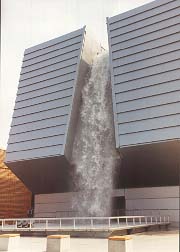
|
|
SYMBOLIC FJORD--Waterfall at Norwegian Pavilion at EXPO 2000.
Photo: ©Glenn Loney, 2000/The Everett Collection.
|
Norway's chrome steel facade is divided by a great rushing waterfall!
Japan's undulating white-skinned pavilion is actually supported by Shigeru Ban's great "Paper Arch," similar to the one now on view in the garden of the Museum of Modern Art in New York. But much, much larger. The structural arches are made of paper-products and are recyclable.
Colombia's multi-sided open pavilion is constructed of reinforced bamboo, with a great sloping roof. Venezuela's pavilion is topped with what seem to be closed petals. These rise hydraulically to form a cactus-like plant-abstraction.
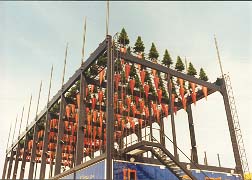
|
|
NOT CARROTS BUT TREES--Automated Estonian Sky-Forest at EXPO 2000.
Photo: ©Glenn Loney, 2000/The Everett Collection.
|
At the top of the Estonian Pavilion, what look like giant carrots are rhythmically rolling in the wind. Actually, they are small evergreen trees in orange cornucopias. They are balanced in the pavilion basement by stones which rise and fall as well.
Stacked Decks of Dutch Landscape!
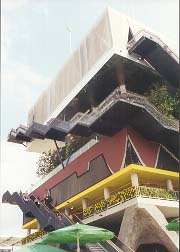
|
|
SIX STACKED LANDSCAPES--Layers of Environment in Netherlands Pavilion at EXPO 2000.
Photo: ©Glenn Loney, 2000/The Everett Collection.
|
The most arresting Environmental Pavilion is that of the Netherlands. It has been designed by the Rotterdam firm of MVRDV, which calls this curious structure "Stacked Architecture."
There are six different landscapes, stacked one on top of another, linked by great exterior staircases and internal elevators. At the top, 36 meters above the ground, there's a small lake flanked by the new small-scale power-generating windmill/propellers.
Below this is a theatre-level, surrounded by a curtain of falling water. Below that is an open level of trees, which seem to support the levels above.
Below this are great flower-pots—with videos projected on them—which represent roots. But below the roots is an entire level of blooming flowers. Like a quick visit to the gardens of Keukenhof in Holland!
And there are also Dunes and Valleys levels below.
The Spanish Pavilion is covered with its natural cork. The Swiss Pavilion looks like stacks of lumber at Home Depot. It is a board-foot-maze that can be recycled back home. Or sold to Hannover builders & contractors.
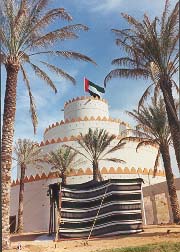
|
|
WHERE ARE THE CAMELS?--Arab Emirates sent the "ships of the desert" back to their home in the Black Forest!
Photo: ©Glenn Loney, 2000/The Everett Collection.
|
Yemen has wonderfully recreated its distinctive architecture. The Arab Emirates have abstracted typical design elements for their castelated pavilion.
They also had some spirited camels on hand. Unfortunately, people kept pushing and pinching the animals, who are notoriously nasty when aggravated. Someone even tried to stub out a cigarette on one of the long-suffering beasts.
So, after the opening day photo-ops, the camels were sent back—not to the Persian Gulf—but to the Black Forest where they were raised.
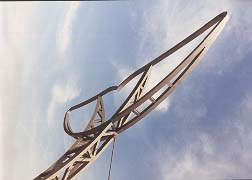
|
|
TAIL OF THE WHALE--Special feature of YMCA/YWCA Pavilion at EXPO 2000.
Photo: ©Glenn Loney, 2000/The Everett Collection.
|
At the bottom of the national pavilions' long-rectangle, a camp of colorful Mongolian tents featured historic dances and rituals. Nearby, in a massive Post-Modernist Whale, the YMCA & YWCAs were doing their bit for World Peace & Brotherhood.
In fact, a number of international Do-Gooders were on hand. B'hai members were as welcoming as could be in their uniforms and neckerchiefs.
God Hovers Over All!
More conventional main-stream religions were also in evidence. The Heilige Stuhl—as usual—had its own pavilion. This isn't German for Holy Stool, but for the Holy See, or the Vatican Pavilion.
And the Christ Pavilion was a major presence as well. Its distinctive feature—aside from a chapel and various religious items—was its double-paned glass walls, filled with syringes, forks, seed-pods, tea-strainers, saw-blades, and the like. These create quite a stunning effect.
Because this represented all Christians—not just Evangelical Lutherans—Catholic authorities had insisted on a window to honor the Blessed Virgin Mary. This caused a problem for Lutherans who do not worship or venerate her.
When I was photographing the walls—and talking with some Americans—a nearby German, affirming his religion, loudly declared: "Ich bin Christ."
My Americans were astonished, even offended: How could this man make such a blasphemous claim? He certainly didn't look like Christ!
I had to explain that the German word for Christian is in fact Christ: as in "I am a Christian." There's also an elitist German jewelry firm called Christ.
Where Was America at EXPO?
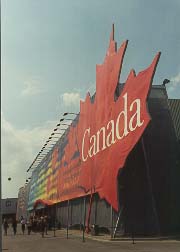
|
|
MAPLE LEAF FOREVER!--Canadian Pavilion tries to make up for failure of United States to have a presence at EXPO 2000.
Photo: ©Glenn Loney, 2000/The Everett Collection.
|
Considering that Canada has an entire Hannover Messe Exhibition Hall at its disposal, and that Mexico has constructed a stunning Post-Modernist glass & steel structure, it is a major embarrassment that the United States of America has no official pavilion—or even a presence—at this Millennial Fair!
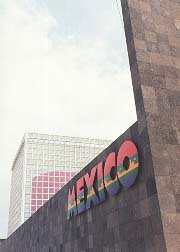
|
|
POST-MODERNIST MEXICO!--South of the Border, they know how to be Good International Neighbors at EXPO 2000.
Photo: ©Glenn Loney, 2000/The Everett Collection.
|
On the opening day, Federal Germany's Chancellor, Gerhard Schröeder—whose power-base is in Lower-Saxony, with Hannover as capital—was present to officiate. He was also able, on the same day, to receive US President Bill Clinton in Berlin.
The ICE superspeed train-trip between these two capitals is only an hour-and-a-half. Why couldn't Clinton at least have put in a brief appearance at EXPO 2000?
In a very real sense, America's absence from the fair is something of an insult to Germany—as well as to all the nations who have come to show their visions of the future. Perhaps, because of that, President Clinton was too embarrassed to appear?
Can it be that America is not represented at EXPO 2000 because our own record on Environmental Issues is so thoughtless and shameful?
That would be an understandable explanation. But the truth of the matter is a bit more devious.
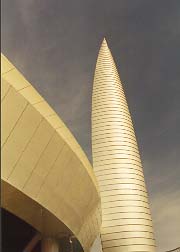
|
|
ITALIAN FUTURISM REVIVED--Sleek Post-Modernist forms of Italy's Pavilion at EXPO 2000.
Photo: ©Glenn Loney, 2000/The Everett Collection.
|
Congress Refuses To Showcase American Achievements!
I am obliged to the New York Times Berlin Bureau Chief, Roger Cohen, for the real background of our national failure to appear in Hannover.
After the World's Fair in Seville, some congressmen were so angered—or disappointed—at the design of the American Pavilion and what it had to exhibit that Congress passed a bill forbidding any future governmental funding of American exposition exhibitions abroad.
As I make it my business to go to World's Fairs and photograph them for the Everett Collection, I saw that pavilion in Seville.
It wasn't exactly a disgrace, but it was mostly open space, flanked by Peter Max murals of our history and legends, and studded with great steel pylons, topped with metal American flags.
Two flanking exhibition buildings contained major American Documents of Liberty, sealed under glass, and some random samples of American Commercial Culture. Not very inspiring, but that was a decision of design and administration. Not sufficient cause to turn congressional backs on future fairs.
The Governor of Arizona honored a great Navajo Chieftain—and there was some Native American Ethnic Dancing—on the day I photographed the enclave.
The next World's Fair, in 1998, was staged in Lisbon, Portugal. This time, the American Pavilion was paid for by corporate and private donations. As at Seville, there were still long lines of people eager to see what America had to show.
There was no exterior to design, as all the national pavilions in Lisbon—as many of them at EXPO 2000—were contained in large box-like halls. Inside, there were some interesting documents and displays. And, as I recall, a great block of ice.
Former Congressman Tony Coelho was the pavilion's head honcho. And now some embarrassing questions are being asked about his stewardship.

|
|
BERLIN BONUS--View of symbolic interior of Daniel Libeskind's dramatic new Jewish Museum.
Photo: ©Glenn Loney, 2000/The Everett Collection.
|
Actually, America was to have had an EXPO 2000 pavilion, but sufficient funding could not be raised from corporate sources.
Instead, the "American Presence" at EXPO 2000 is invoked on behalf of MacDonald's™ and Coca-Cola™, both of whom are corporate sponsors. And whose products are to be found everywhere on site.
The plot reserved for the United States—which should have featured a Main Street USA—was filled at the last minute by Romania, of all possible replacement nations!
This simple but handsome pavilion is a great elongated box—similar in shape to many others—but it is effectually a grand trellis supporting living vines. It makes a strong visual statement about the Environment. And it's very cooling on hot summer days!
EXPO Entrance Costs Too Much!
One thing about planning for EXPO 2000 bothered me long before I requested a Press Pass. The admission-price had been set at DM 69—even more if you bought your ticket at the entrance, for some strange reason.
That's a lot of money for most people, even Americans, especially if you are going to spend a lot of your day just standing in like waiting to get into a Theme Pavilion.
On the day before opening, there was so much left to be done: exhibits installed and tweaked, lawn sections laid down, walls painted, that it seemed impossible EXPO 2000 could open in only 12 hours.
But it did, and most things were in place. All sections of the fair-grounds were thronged with visitors. Bands and dancers were performing everywhere, it seemed.
Albert Speer's grand elevated promenade and stairs, joining the two major pavilion-areas, looked rather like the parade-architecture Speer Senior designed for the Nazi Party Rally Grounds in Nuremberg.
Opening Day was also Christi Himmelfahrt—or the Feast of Christ's Ascension into Heaven in His Incorruptible Human Body. This is a national holiday, so thousands were on hand, many with complimentary tickets, owing to some involvement with EXPO 2000.
The next day, Friday, was a work-day, so the small turnout wasn't too surprising. But on Saturday and Sunday, when few have to work, the grounds were even more deserted. I didn't have to use my Press Card to buck the long lines into the pavilions.
Almost Alone Inside the Great Wall!
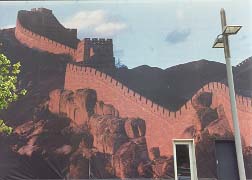
|
|
THE DOOR IN THE GREAT WALL--At EXPO 2000, China's Pavilion is covered with immense photographs of its historic first line of defense.
Photo: ©Glenn Loney, 2000/The Everett Collection.
|
There weren't any lines to speak of. You could walk right on in. I had the China Pavilion almost to myself. As the pavilion is covered with photo-blowups of the Great Wall, this was quite an experience.
The next week, 500 hourly workers—mostly in souvenir shops and food-service facilities—were immediately discharged.
EXPO 2000 management refused to consider reducing the admission-price. They may not have done their homework. It was reported that they even expected to make a profit, not just break-even.
One heard repeatedly, even in the city, that the great costs of mounting the fair had to be covered. But the projected corporate sponsorship had not materialized as fully as hoped.
International Expositions Are Never Money-Makers!
No World's Fair—not to mention both Victorian Crystal Palaces, in London and New York—has met its costs, let alone made a profit! Taking a loss—or a bath—is the rule.
But the ultimate reward is providing a major showplace for international innovations and aspirations.
EXPO 2000 might think about making entry entirely free. And write-off the costs as an investment in goodwill for Germany and as an evidence of the Promise of the European Union!
Considering the scores of souvenir shops, ethnic boutiques, elite and popular restaurants, and other money-spinners, a lot of income can still be generated from the thousands who should be thronging these avenues and wonderful pavilions.

|
|
ASIAN GEOMETRIES--Pavilions of India and Korea at EXPO 2000.
Photo: ©Glenn Loney, 2000/The Everett Collection.
|
EXPO 2000 Is Not a Leisure Park!
Commentator Georg Giersberg—writing in the prestigious Frankfurter Allgemeine—suggests someone has made a mistake if EXPO 2000 is being marketed as a Leisure Park experience for the family.
He notes the astonishing statistic that Germany now has no less than 53 large Leisure Parks. Each attracts over 100,000 visitors each year.
Entrance costs DM 30—about $15. This is less than half the price for EXPO 2000, which is hardly a Leisure Park experience.
EXPO 2000 does have an immense Ferris Wheel and a hall devoted to lackluster entertainments for children and teens. But it has nothing resembling the Midways or Gayways of fairs of the past, with all kinds of rides and sideshows.
It is something else entirely. It is a mind-expanding Educational Experience that is both fascinating and fun. You can enjoy a metaphoric trip Around the World at EXPO 2000 in far less than Eighty Days!
I return to Germany in July. As my Press Pass is still good—until after the performances of Peter Stein's Faust I'm hoping to see—I will certainly return several times.
How To Get To EXPO 2000!
I urge readers who have not yet made holiday plans to consider EXPO 2000 as a once-in-a-lifetime adventure!
I'll even recommend my favorite travel-agency, Mercator, which is also official New York agent for German Federal Railways.
Not only did its director, Roswitha Sterbal, book me a money-saving flight on Singapore Airlines from JFK to Frankurt/Main. But she also got me a special rate at the Best Western Four-Star Hotel Kronsberg. Sumptuous breakfast included!
It's right beside the fair-grounds, which are some distance from the city-center The President of Brazil was there also, but I didn't see him at the pool.
You can actually get off your international flight at the Frankfurt Airport and go directly to board the high-speed ICE trains to major German cities, including Hannover.
The local S-Bahn also takes you swiftly into the center of Frankfurt. Which is more than you can say for either LaGuardia or JFK, in relation to Manhattan.
An interesting EXPO holiday plan could include flights to Frankfurt, Hamburg, Berlin, or Munich—with local sight-seeing—followed by a luxurious ICE train-ride to the Messe. Thanks to the German Rail Pass, I managed side-trips to both Berlin and Frankfurt!
Mercator is located in the Art Deco Chanin Building—across from Grand Central—at 122 East 42nd Street, NYC 100168, Suite 3006. Phone: 212-682-6979. FAX: 212-682-7379.
Free Shows at the Fair-grounds &
Nights at the German Opera/Theatre:
At EXPO 2000, there are free performances of Music, Dance, and Street-Theatre at all hours all over the fair-grounds. If you are strolling down an exhibition boulevard and hear some frantic drumming, rush along to check it out!
The dancers/singers/musicians may be Caribbean, South American, African, Middle Eastern, or Asian. Or they can even be grown men, dressed as women, in wooden witch's masks, recreating ancient Tyrolean seasonal dances!
On opening day, the thunderous thumpings of STOMP's trash-cans greeted early arrivals and almost drowned out the inaugural rituals.
There's a little bit of everything on view. Including America's Bread & Puppet Theatre, with its famous street-carnival warm-ups, to attract audiences into its own large theatre-space in the Human Needs Theme Pavilion.
New Yorkers may already have seen Peter Schumann's "Needs Cantata" and "Resurrection Mass"—recently tried out in Manhattan at the Theatre for the New City—but both work much better in their grand space at EXPO 2000. It is decorated with a series of bays, each featuring the giant puppets, masks, and constructions of some of Bread & Puppets' most famous productions.
Their frequent performances are free and will continue throughout the fair. But there are other national and ethnic groups also performing in this special Theme Pavilion.
In the vast Hannover Messe exhibition halls—already long in place on the fair -grounds—individual national exhibition-sites also feature regular free performances of native dance and music ensembles. Major separate national pavilions also have informal performances in public-spaces and special shows in purpose-built theatres.
But there are also several large new concert, theatre, and event-spaces on the fairgrounds. With some of the world's most famed orchestras, dance-groups, theatre-ensembles, rock bands, and the like programmed throughout the fair's five-month run.
Kurt Masur conducted the New York Philharmonic on June 14, America's Flag Day. And Pina Bausch's notorious Tanztheater Wuppertal will be on hand with one of her enigmatic and trendy new choreographies.
Peter Stein's Faust Epic—
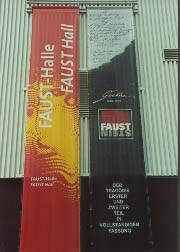
|
|
PETER STEIN'S "FAUST"--Goethe's 21-hour Epic rehearses in vast hall at EXPO 2000.
Photo: ©Glenn Loney, 2000/The Everett Collection.
|
The Big Event, however, will be Peter Stein's epic 21-hour production of Johann Wolfgang Goethe's Faust, Parts I & II. Even before the opening of EXPO 2000, Stein was already rehearsing his large cast in a vast exhibition hall, devoted entirely to this adventure in avant-garde theatre.
This is the production Peter Stein has long dreamt of mounting, but its costs and logistics daunted most theatre-managers.
Not since the great late Gustav Gründgens staged both parts of Faust—first in Hamburg, then at the Salzburg Festival—has any major European director dared to produce this epic philosophical spectacle in its entirety.
What's more, Gründgens starred in his own staging. Not as Faust, but as Mephistopheles—a much more interesting role.
Stein won't star, but—as one of the most innovative and intelligent directors working in contemporary theatre—his production will certainly proclaim his subtexual stardom.
Gründgens' brilliant Modernist two-day production—which I saw both in Salzburg and Hamburg—was long, but not 21 hours long. Gründgens, by the way, was the central character in the film, Mephisto, starring Karl Maria Brandauer.
He was, in fact, something of a Mephistopheles, having prospered as a leading actor-director of theatre and cinema under the Nazi regime. After World War II, he continued to have a distinguished career.
He'd been saved from Concentration Camp internment for homosexuality by no less a celebrity than Emmy Goering, wife of the Reichsmarschall. Gründgens had given the Frau Reichsmarschallin her first acting work.
Stein says he's presenting an uncut Faust. Part II was never played in Goethe's lifetime, but an uncomplicated staging could be presented in five hours or so.
Stein has announced that his staging will rove around the vast exhibition-hall space, and audiences will follow along. This is not exactly a new idea, as it was already exciting audiences in the 1960s.
Orlando Furioso, in a bubble-tent in Manhattan's Bryant Park, was an unforgettable experience, for example. Especially if you needed desperately to sit down! Now over 70, I do like to sit when I'm at the theatre.
There are a limited number of performances in late July and early August. But the production will travel to some major European cities, such as Vienna.
Perhaps it can come to BAM? If you want to spend two days—and 21 hours—in the Harvey Lichtenstein Theatre?
Robert Wilson's epic about the Life & Times of Josef Stalin—in BAM's Opera House years ago—lasted twelve long hours. By the dawn's early light—as 40 ostriches spun in place on the stage—Clive Barnes, John Simon, and I were the only critics left in the house. Not many of the audience survived that long either.
When Peter Stein was Head of Theatre at the Salzburg Festival, it was his hope to stage the complete Faust there. But that was something he was denied, which may have led to the break with Artistic Director Gerard Mortier.
With so much free theatre, music, song, and dance around the fair-grounds, Stein and his ensemble may have a difficult time to attract ambulatory spectators.
For trendy teens and twenties, there's also an immense EXPO Disco. It has two entrances—one inside the fairgrounds, the other outside—so it's not necessary to buy an Expo entrance ticket.
Indeed, tickets to performances on the EXPO site include entrance fees and free public transportation three hours before—and after—the shows. How about trying this in New York?
The Disco is conveniently located near the end of the EXPO-OST tram-line, which takes only 20 minutes to reach the center of Hannover.
Although hundreds of young people were thronging outside the Disco, I took the tram—and the free-ride—in the other direction. I had arranged to see two excellent opera-productions and one fascinating theatre-adventure. All this not on the EXPO site, but in the heart of this ancient Electoral Capital—birthplace of the British Windsors' boorish ancestor, George I.
A World Premiere & a Modern Classic
At Hannover's Historic Opera-House—
Actually, the Hannover Opera House is the home of what's officially known as the Niedersächsischen Staatsoper. Or the State Opera of Lower Saxony.
Before Germany's disastrous defeat at the close of World War I, Hannover [always with two n's, not one] was the capital of the Kingdom of Lower Saxony. When the Guelph/Welf ruling family dispatched Prince George to London to become King George I of England, the rulers were Electors, among those who voted for the Holy Roman Emperor.
England's four King Georges—and King Billy—retained the Hanoverian style-and-title of King.
In the 19th century, Queen Victoria—a direct descendant, who cou ld not succeed to the title—sent the Duke of Cumberland to rule as King of Lower Saxony.
The magnificent Opera House—resembling those neo-classical wedding-cake opera-theatres in Berlin, Munich, and Frankfurt—on its pediment bears the name of King Ernst August, who was ever eager to improve the cultural lives of his people.
Prince Ernst August—the man who would be king, if there still was a throne to occupy in Hannover—was a center of attention at the opening EXPO 2000 Gala. That was not only because of his historic title, but also because his wife is Princess Caroline of Monaco!
So much for the styles-and-titles of the House of Hannover. There is, however, no Elitism at the Staatsoper. The general public is not only welcome, it's ardently courted by the management, with a variety of special initiatives to encourage attendance.
The Gilgamesh Commission—
The ancient Babylonian Epic, Gilgamesh, has fascinated both theatre and dance ensembles. Decades ago, when there was still a Hunter College Concert Hall, the Polish Mime Theatre brought its stunning performance version to New York.
More recently, various ensembles in Manhattan and farther afield have mounted their own visualizations of this Ur-Fable. In Hannover, composer Volker David Kirchner was commissioned to create a new Expo Opera on this fundamental tale of the search for the Meaning of Life.
This is such an impressive achievement in modern opera that it deserves to be widely performed. Kirchner has created his own very effective libretto, based on an outline of Imad Atwani.
Gilgamesh is an Ur-Fable in two senses. First, in the sense that it deals with the saga of the goddess-descended King of Uruk, Gilgamesh. Secondly, in the sense of being a primal—or Ur—legend of human self-realization in the Cradle of Civilization.
Gilgamesh's story includes the Great Flood—with no mention of Noah and the Ark. So this legendary record is one of the oldest of Mankind's epics to survive, aside from those in the Pentateuch.
If you cannot go to Hannover to see the opera, you might want to go to the Morgan Library. You can experience some precious survivals of the world of Gilgamesh. Its splendid current exhibition is the Treasures of the Royal Tombs of Ur!
Kirchner's retelling of the Gilgamesh tale, as in the historic record, is of necessity episodic. It's almost a picaresque adventure-tale, but on an Heroic Scale.
Not only does his score provide some powerful arias and duets for its hero, his equally heroic friend Enkidu, the fabled Babylonian hunter Nimrod, the power-hungry High Priest, and Gilgamesh's goddess-mother, but there are also impressive choruses.
Gilgamesh's mother Nin-Sun is Goddess of Wisdom—a much earlier version of the Greek's Athena—and she has some good advice to give him.
But he has to be on his guard with Ishtar, the Venus-goddess, however: Lust can destroy; Love can liberate.
As in all great epics that were to follow, the Hero has to overcome obstacles: Human, Natural, and Superhuman. Gilgamesh is equal to all challenges, in his search for Eternal Life beyond this life.
To enter the Underworld, he has to safely pass the two giant Scorpions who guard the gates to the Hereafter. Even these menacing creatures are moved by his pleas.
The talented Hans-Peter Lehmann has staged, with sets & costumes by director-designer Ekkehard Grübler—whom I used to know years ago at the Munich Opera.
Lehmann has mounted the opera as a kind of Grand Ritual Mystery. The center of the stage is filled with a rising ramp, growing smaller at the upper end. All the action moves up and down this incline, while the chorus is often flanking the ramp.
Framing the stage-picture is a series of girder-like beams, vertical and horizontal. The lateral elements can dip down from their customary framing-positions.
Grübler's grand costumes are almost hieratic, surreal, symbolic. They recall Norman Bel Geddes' fantastic robes for Max Reinhardt's epic production of The Miracle.
This premiere production—conducted by Stefan Sanderling—was one of the highlights of my visit to EXPO 2000. Among the outstanding vocal talents were Bernd Valentin—as Gilgamesh, Axel Wagner, Hans-Peter Scheidegger, Karin Zelles, Carola Guber, and Carola Rentz.
A Charming Rosenkavalier—
To those American opera-lovers who know only the star-names from the Met, Covent Garden, and the Opera Bastille, it may come as a surprise to realize that there are literally scores of talented young opera artists performing in Europe on State and City opera-stages.
Post-war Germany at one time boasted over 200 such theatres. That number has been reduced, owing to increased costs of production—all government-subsidized—and declining audiences—who now have too many TV channels to watch.
Nonetheless, Hannoverians do tear themselves away from the boob-tube to visit their handsome opera-theatre for such productions as Gilgamesh and the revival of Ekkehard Grübler's staging and design for Richard Strauss's Der Rosenkavalier.
Revived by Lehmann, the performances are as fresh and vital as at a premiere. But the sets look a bit shop-worn, though grandly neo-baroque in their original conception.
You may never have heard of Hannover before, let alone of its Opera. But the State Opera has always had a high standard of performance.
The current Rosenkavalier is an audience triumph for Gabriele Fontana, as the Marschallin, the Fürstin von Werdenberg. But the Octavian of Annette Seiltgen and the Sophie of Carmen Fuggis were both so outstanding that we are sure to hear more of—and from—them on major opera stages in the future.
Christoph Stephinger was an amusing and rowdy Baron Ochs von Lerchenau. Gregor Bühl conducted with wit and elegance.
Opera & Ballet in Herrenhausen—
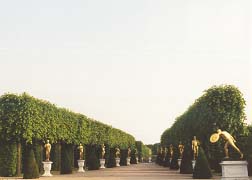
|
|
HANNOVER'S HISTORIC HERRENHAUSEN HEDGE-THEATRE--Site of opera, drama, & ballet performances this EXPO summer.
Photo: ©Glenn Loney, 2000/The Everett Collection.
|
In addition to special opera performances programmed as part of the EXPO 2000 events, there are also regular summer outdoor performances in the historic Heckentheater—or Hedge-Theatre—in the great Baroque Gardens of Herrenhausen.
This was the ancestral seat of the Hannoverian rulers, but the great palace is gone. The Orangerie and the Royal Stables, however, are almost palatial. And the magnificent Gardens, with many neo-classical sculptures, certainly are palatial.
A summer highlight is the annual Equestrian Ballet in the gardens, complete with fireworks and the gushing royal fountains.
Even if you don't manage to visit Hannover for the World's Fair, it's well worth a visit next summer for its full program of cultural presentations.
A Full-House of Short Plays
At Hannover's Schauspielhaus—
Although Hannover's Opera-House is neo-classic on the outside, it has had a Post-Modernist remodeling inside. Nearby, the State Drama Theatre is fiercely Post-Modernist both outside and in.
On the evidence of one evening's wild theatre-adventure, I can well believe that its other productions are cutting-edge avant-garde as well.
This program of eight individual plays was titled HALT.LOS—Autorenspektakel. And it proved to be an Authors' Spectacle indeed, as eight playwrights—not all of them German—showed their inventiveness.
If one really was determined to get money's-worth, at best one could only manage four of the plays between 6 pm and midnight. With partying in between and afterward!
One of the shows was performed in the Theatre Museum, part of the theatre-complex. Others were played on the back-stage, in the two rehearsal halls, and on the main-stage.
One of the plays, Rainald Goetz's Jeff Koons, is not actually about that formerly trendy American Conceptual Artist. Instead, it takes a sharp satiric look at the cultural scene today.
Some years ago, Jeff Koons erected a gigantic dog outside an historic German railroad-station—was it in Hannover or Kassel?—so his name and art-objects are well-known in Germany.
Almost the first thing I saw on my return to Manhattan was an immense copy of Jeff's flower-speckled, wire-mesh greenery-covered Puppy in Rockefeller Center. So how about performances of the Jeff Koons play as well?
Other plays included Legoland, Sleeping Around, Berlin Story, Alpen-Hegel, and three world-premieres.
I didn't have time to see Überall in der Badewanne wo nicht wasser ist, but the other two premieres were well worth a visit, showing the widely contrasting styles the Schauspielhaus ensemble can play with ease.
Friedrich Karl Waechter's Die drei Letzten—The Three Last Customers—features three old cabaretist cronies in a bar at closing-time. They involve the pretty young bar-maid in their re-enactment of scenes from former times. This was charming.
Far more surreal was Wilfrid Happel's Fressorgie, oder Der Gott als Suppenfleish. On a paradisical island, some powerful holiday-makers are fed dainty morsels with European Union flags stuck in them.
From the hideous screams and sounds of chain-saws offstage, it's apparent that the snacks are made of the hacked flesh of the obsequious, nervous foreigner who has just presented himself at the door of the hotel. Perhaps seeking employment?
This could very well be a surreal parody of the pathetic eagerness of former East Block Nations to join the Western European Powers in their adventure in economic unity.
But what happens when you discover that you have been eating your long-lost son? Or the flesh of a God? Of course, this is the basic miracle of the Eucharist: Bread Becomes Body—Divine Flesh.
Not only was this riotous knockabout comedy, but it was also a musical! I was delighted to discover the varied talents of the cast, not only as farceurs, but also as sophisticated musical-comedy performers.
Outstanding was Asad Schwarz—another Charlie Chaplin!—as the sacrificial son of Grosser Hase, or Big Bunny, played by Bernd Geilig. As Spoon, the hotel-chef, Volker Langeneck was wonderfully suave and comic, throwing trays and chairs over the Paradise Island backdrop, letting them crash backstage.
They should do this kind of multi-play & party at the Public Theatre and the Vivian Beaumont as well!
The Schauspielhaus management also knows how to attract audiences, even at the end of the season, when summer holidays and Expo beckon. For about $50, you could get a set of ten tickets—$5 per show!—to the final performances of productions in the repertory.
These included the classics: Shakespeare's Wie es euch gefällt, or Twelfth Night; Lessing's delightful comedy, Minna von Barnhelm, and his masterpiece, Nathan the Wise; and Kleist's Prinz Friedrich von Homburg.
Heinrich Mann's Professor Unrat—known in cinema as The Blue Angel—was among the choices, as was Thornton Wilder's Our Town. And plays with names like Girlsnightout, Fidibus, I Hired a Contract Killer, Eiche und Angora, King Kongs Töchter, Forever Young, Ein Mann zuviel, Die Eisprinzessin, Sentimental Journey, and SCHNULZ!
The English-language titles are those used by the theatre. Perhaps another example of European Union at work? English is the official language of the EU, after all.
Two Post-Modernist Productions
At the Admired Frankfurt Opera—
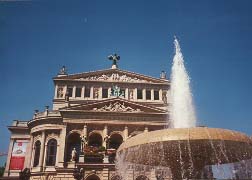
|
|
FRANKFURT'S "WEDDING-CAKE" OLD OPERA-HOUSE--Scene of tour-stop for "STOMP" this summer.
Photo: ©Glenn Loney, 2000/The Everett Collection.
|
My first exposures to the powerful productions of the Frankfurt Opera were in the second half of the 1950s. I actually saw the great director, Carl Ebert, on stage as Skigolch in Alban Berg's Lulu. These were also the great days of Intendant/director Harry Buckwitz.
When I stopped by the administrative offices to ask for press-tickets, I recalled that time. But I completely forgot to tell the friendly staff that I had also seen the late Ruth Berghaus's highly controversial production of Wagner's RING over a decade ago at the opera-house as well.
I was in the director's box—at Berghaus's invitation—on the last night of the season, when GMD & conductor Michael Gielen was making his farewell from running an opera ensemble.
I thought the riotous students in the balconies would tear down the house. Great banners were unfurled: Die güte Zeiten sind vorbei! Es ist das Ende von Alles!
You might have thought there would never be any good innovative productions on that stage again. You would, of course, have been very wrong.
A sample of the repertory for the forthcoming season includes Nabucco, Wozzeck, Falstaff, Poppea, Bohème, Luisa Miller, Zauberflöte, Holländer, Eugen Onegin, Freischütz, Cavalleria, Bajazzo—Pagliacci, Peter Grimes, and Die Eroberung von Mexico—The Conquest of Mexico, by Wolfgang Rihm.
A New Look at Mozart's Così fan tutte—
Designer Johannes Leiacker's hydraulic stage-surface was an obvious visual metaphor for the ground shifting under the feet of the two pairs of lovers in Mozart's anti-romantic comic-opera, Così fan tutte, at the Frankfurt Opera.
This great white square, angled downstage right, inclined to left and right, upstage and down, as the chemistry of the relationships altered—with the young officers testing the fidelity of their sweethearts, while disguised as flamboyant Turks.
Katherina Eberstein's stylish costumes for the principals evoked the era of Mozart. And of his ingenious librettist, Lorenzo Da Ponte—later teacher of Italian at Columbia College in New York City.
But the chorus—instead of coming on in charming period costumes of Italian peasants—clambered onto the shifting square, dressed formally as if for a concert. Later, the men wore waiters' aprons, as wedding festivities threatened.
This modernist touch wasn't helpful or meaningful. Fortunately, director Annegret Ritzel was able to strike fire with her talented cast. The excellent Fiordiligi and Dorabella were Anja Harteros and Nidia Palacios.
Johannes Martin Kränzle was an amusingly frustrated Guglilelmo, while Ilya Levinsky's Ferrando was somewhat sabotaged by a Costume à la Turque which showed too much paunch.
Barbara Zechmeister was a fine Despina, with Andreas Macco a sinister Don Alfonso.
Why is he setting up these two charming but brainless women for humiliation? And the young officers for bitter disillusion? Does he have some kind of sexual disfunction himself, hanging around the barracks all the time?
Balázs Kocsár conducted with close attention to the needs of the staging.
Shifting Solid Scenery for Der Troubador—
The most impressive aspect of this Frankfurt production of Il Trovatore was its scenic centerpiece, composed of four bone-white movable structural sections.
Francesco Calcagnini's symbolic architecture suggested the golden horseshoe of an opera-house. Or the Romanesque choir of an ancient cathedral. Or the great hall of a medieval castle.
Set in the center of a great black-box of a stage, it was moved about, in various conformations, in full view of the audience. Its versatility was thus demonstrated, as well as the way in which such great opera stages function technically.
Great sidewalls rose stage-right and stage-left so elements could be rolled offstage onto unseen side-stages the same size as the main-stage. An upstage wall also rose to reveal a stunning silhouette of the Anvil Chorus.
The lighting-effects were also strongly symbolic and attractive. Even the costumes were quasi-historical.
Unfortunately, the modern haircuts of the two ill-fated brothers, Manrico and Graf Luna, wouldn't be out of place in Wall Street. Nor would their semaphore-style gestures be amiss on the trading-floor of the Stock Exchange.
Stodgy and wooden don't begin to describe their acting. They sang their roles stalwartly, however.
Elisabetta Fiorello's Azucena was much more spirited. After all, she's seeking revenge on Count Luna for burning her grandmother at the stake. Not to overlook her long-term anguish at having thrown her own baby onto the pyre, in a moment of distraction. You wouldn't want her for a baby-sitter.
Duna Simic was a lyrically and visually lovely Leonora, but stage-director Antonio Calenda too often abandons her to hand-wringing and arm-waving on an empty stage. She would be stunning, given effective direction.
Nonetheless, the score was given a brisk reading by conductor Catherine Rückwardt. Her last name means Backward, but there is nothing at all backward about her skills in the pit or her sensitivity for Verdi's music.
Frankfurt's Schauspielhaus & Kammerspiele—
The huge theatre-complex which includes Frankfurt's modern opera-house and its two city theatres—main-stage and small-stage—fills an entire block on Willy Brandt Platz in the heart of Germany's financial center.
Unfortunately, I had time only for two operas and no plays or musicals, so I missed the City Theatre's production of Hair, staged in the Kommunikationsfabrik.
Not to mention Ballet Frankfurt and Needcompany's production, at the Bockenheimer Depot, of DeaDDogsDon'tDance (DJamesDJoyceDead) , created by choreographer Jan Lauwers. His Needful ensemble was recently at BAM, so this new show may be on its way to New York as well!
At the historic Old Frankfurt Opera—very like the great theatre wedding-cakes of Dresden and Berlin—STOMP will fill its noble auditorium in late June-early July. This was a bombed-out shell for decades, reconstructed as a concert-hall, as Frankfurt had already built the modern opera-house shortly after World War II.
The theatre-season ends on June 30. If you are able to stop over in Frankfurt on your way to or from EXPO 2000, you might want to see Harold Pinter's Asche zu Asche, Samuel Beckett's Endspiel, Friedrich Dürrenmatt's Die Physiker—The Physicists and Die Besuch der alten Dame—The Visit, Oscar Wilde's Bunbury, oder Wie wichtig es ist Ernst zu sein, Alexandre Dumas' Kameliendame, Anton Chekhov's Der Kirschgarten, Friedrich Schiller's Don Carlos, J. W. Goethe's Faust I, or Sophocles' Antigone.
I was especially disappointed to miss two productions of savagely satiric dramas by Austria's severest critic, the late Thomas Bernhard: Heldenplatz and Über allen Gipfeln is Ruh.
It would also have been rewarding to see Ödön von Horváth's Geschichten aus dem Wiener Wald—Tales of the Vienna Woods. As well as Marieluise Fliesser's Fegefeuer in Ingolstadt.
Not to overlook King Kongs Töchter, Alzheimer Roulette, and Peter Hacks' Gespräch im Haus Stein…. This was once wonderfully performed—however briefly—on Broadway by Uta Hagen. And Charles Nelson Reilly, who had no lines, only reactions to the fury of Charlotte von Stein, abruptly abandoned by her lover Goethe.
Peter Brook's recent Paris Bouffes du Nord production of The Costume is scheduled for the end of June on the main-stage.
New productions in the coming season, beginning September, include Johann Strauss's Die Fledermaus, Mérimée's Carmen—not the opera, Shakespeare's Midsummer Night's Dream, Calderon's Life Is a Dream, Strindberg's Dream Play, Hauptmann's And Pippa Dances, O'Neill's Long Day's Journey into Night, Irving Walsh's Trainspotting, and, of course, Jeff Koons!
Doesn't that make the programming at the Vivian Beaumont Theatre look sick? It was created to be the New York equivalent of such European city-supported repertory theatres as Frankfurt's and Hannover's. Its initial ensemble was even named the Lincoln Center Repertory.
So much for American Cultural Aspirations. And for New York's self-congratulatory vision of itself as the Cultural Capital of the World. Ho ho!
Rosalie's Frankfurt "Dandelions"

|
|
ROSALIE'S AUTOMATED "DANDELIONS"--Artist's special summer installation in Frankfurt's Palm Garden.
Photo: ©Glenn Loney, 2000/The Everett Collection.
|
An added treat in Frankfurt was my expedition to its Palmengarten, near the Joahnn Wolfgang Goethe University.
Ordinarily, I wouldn't have gone to see palm-trees, cactus, and other exotica out of their natural habitats. For instance, I have never been to the Bronx Botanical Gardens.
But the distictive and very original artist, Rosalie, had invited me to look at her new site-specific art-installation, which she calls "Dandelions."
We met a decade ago at Bayreuth, when she became the first woman ever to design sets, costumes, and lighting for Richard Wagner's epic Ring of the Nibelungen.
I interviewed her for a major feature on the Ring for Theatre Crafts. Since that time, she has always kept me posted on new shows and achievements.
From the photo on her invitation, I thought her creations must be something like colorful giant dandelion heads.
They are indeed colorful, in a range of pastels. But they don't just stand there around the pool in the Palm Garden Park.
Topping sturdy metal poles, they look like slack mop-heads—until they begin to revolve, flaring out into spherical shapes. These revolutions are programmed, so some are standing still, while others whirl merrily.
Then comes a magic-moment when all are whirling together. This would be nice to see installed in other parks. Children seemed delighted with it.
Edinburgh Bulletin!
The thick program-catalogue has just arrived from the Edinburgh Fringe Festival, on view in August 2000. In addition to the elitist entertainments of the long-established Edinburgh Festival, the Fringe is offering ensembles and solo-performers from all over the world in varied shows, many of them avant-garde.
Here's the current count of productions expected, by types:
Theatre—479 shows.
Comedy & Revue—264 shows.
Musicals & Operas—51 shows.
Dance & Physical Theatre—72 shows.
Music—340 shows.
Children's Productions—60 shows.
Talks & Events—39 shows.
Visual Arts—45 exhibitions.
Wow! Make Edinburgh your August holiday destination!
[Loney]
Copyright © Glenn Loney 2000. No re-publication or broadcast use without proper credit of authorship. Suggested credit line: "Glenn Loney, Curator's Choice." Reproduction rights please contact: jslaff@nymuseums.com.


















